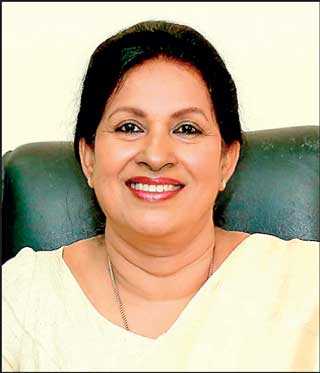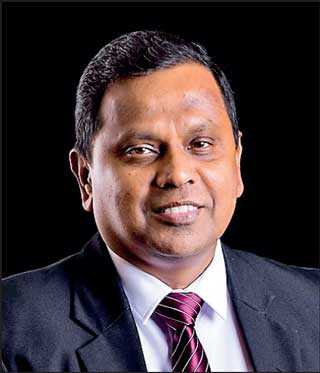Sunday Apr 20, 2025
Sunday Apr 20, 2025
Wednesday, 3 March 2021 00:00 - - {{hitsCtrl.values.hits}}
 |
| HDFC Bank Chairperson Wasanthi Manchanayake |
 |
| HDFC Bank GM and CEO Palitha Gamage |
A farsighted management strategy has enabled HDFC Bank to achieve impressive financial results in 2020. This was despite operating in a very challenging environment due to the COVID-19 crisis and the resultant economic troubles.
The bank has seen significant growth in key financial indicators. The profit before tax for the year ended 31 December 2020 was Rs. 978 million. This is a sharp increase over the previous year’s figure of Rs. 774 million. The net interest income also rose from Rs. 2.9 billion to Rs. 3 billon over the same period. Total assets grew from Rs. 55.9 billion at end 2019 to Rs. 60.8 billion by end 2020.
HDFC Bank Chairperson Wasanthi Manchanayake attributed their success to a number of factors. These include a practical strategy to deal with the COVID-19 crisis, efficient customer service, technological deployment and a diversified product range. “We performed well despite our obligation to serve the housing requirements of the people,” she noted.
HDFC Bank was established under a special act of Parliament which imposes statutory responsibilities. Its core business is providing housing loans for low and middle income people in Sri Lanka, with the majority of loans being disbursed for this purpose. However, it has a diverse portfolio that caters to a range of financial requirements.
Manchanayake was optimistic about the bank’s future. She said their plans for this year include expanding the branch network from 39 to 48 branches across the country, introducing new services and enhancing customer service levels.
HDFC Bank General Manager/CEO Palitha Gamage said a proactive management strategy laid the foundation for their performance. “We prepared for the COVID-19 crisis well before things got bad,” he noted. According to him, the bank’s dynamic corporate culture enabled them to adapt to the evolving situation.
Gamage pointed out that they had provided much relief to borrowers affected by the pandemic. He added that last year, they offered over 21,000 moratoriums on loans amounting to Rs. 17 billion. These concessions cost the bank nearly Rs. 400 million in lost income. Most of the debt moratoriums – which began in April last year – were for a period of six months.
HDFC Bank had a proper system in place before the COVID-19 crisis became serious. This, along with the professional attitude of the management and staff, enabled it to emerge unscathed. The bank continued to operate in both curfew and non-curfew areas across the country. It also followed a prudent yet effective approach in operational cost and asset/liability management.
“Our core banking system proved to be a great advantage,” said Gamage. He noted that it gave them the technological capability to work without disruption. Since its implementation in 2017, this system has greatly enhanced the bank’s efficiency and ability to offer convenience to customers. It has also facilitated the introduction of a diversified product range.
During the pandemic, HDFC Bank utilised its fully-automated loan origination system. The paperless online approval system proved very useful. An advanced communication network with automated dual linkages also facilitated interaction between the head office, branches and customers.
Digital technologies such as mobile apps greatly benefitted customers. An example is the JustPay platform operated by Lanka Clear, which enabled customers to pay utility bills, insurance premiums and mobile reloads, etc., in a secure and hassle-free manner using HDFC Prathilaba Savings account. To overcome constraints arising from the pandemic, virtual meetings were regularly held between senior management and directors. They were thus able to formulate strategies and implement decisions on a fast-track basis. In December, over 250 employees were promoted following virtual interviews. Corporate management was also restructured, and the branch network reorganised into six regional zones (from the earlier five) to ensure closer supervision by regional managers.
Gamage noted that the bank has now emerged stronger and better prepared to face any challenge. “Like they say, when the going gets tough, the tough gets going,” he remarked.
HDFC Bank Chief Financial Officer Anura Hettiarachchi said that despite the pandemic, the bank’s deposits had grown significantly. He noted that their savings and fixed deposits increased from Rs. 42.5 billion at end 2019 to Rs. 48 billion by end 2020. “As for our lending portfolio, we have maintained it at a steady level as before,” he added.
According to Hettiarachchi, the earning per share on profit has seen a positive trend. In fact, the basic earnings per ordinary share rose from Rs. 7.35 in 2019 to Rs. 8.90 in 2020. The bank’s stock presently trades at Rs. 40 to 45 in the market compared to the Net Asset Value of Rs. 87.
HDFC Bank is presently the market leader in housing development finance. It benefits from a unique state-private ownership structure. The controlling stake of 51% is held by the Government while private companies and individuals have a 49% share. It was a State entity until it was listed on the Colombo Stock Exchange in 2005, resulting in private sector investment. It thus benefits from the stability and security provided by the state coupled with private sector efficiency.
Today, the bank offers a diverse portfolio of loan and savings products. Besides housing finance, its main activities are leasing, deposits, business loans, educational loans and pawning. It caters to customers with various financial requirements, including professionals, state and private sector employees, pensioners and SME entrepreneurs.
HDFC Bank has been engaged in housing development finance for over three decades. It began diversifying its product portfolio in 2012 and ventured into new market segments. The new areas of business included leasing and SME loans. This bank’s diversification strategy was a success. Today, it caters to niche customer segments with innovative products that go beyond the core business of providing housing loans.
In recent years, HDFC Bank has introduced new processes covering everything from administration to IT. Currently, it offers digital banking solutions including online payment and e-banking services branded as ‘HDFC Click’. Its core banking system has greatly supported its growth strategy.
HDFC officials said their palmtop banking concept has proved quite popular. In fact, this doorstep banking service is currently used by thousands of customers. Among those who have benefitted the most from it are small-time businesspeople and the self-employed. Its appeal is due to the total convenience and sense of security it provides.
Driven by a strong management team and energetic staff, HDFC Bank has much to be optimistic about. An advanced digital platform has laid the foundation for an innovative future. While enabling many people to realise their housing dreams, the bank also focuses on business growth and optimising returns to shareholders. It is a vision for long-term sustainability.
Discover Kapruka, the leading online shopping platform in Sri Lanka, where you can conveniently send Gifts and Flowers to your loved ones for any event including Valentine ’s Day. Explore a wide range of popular Shopping Categories on Kapruka, including Toys, Groceries, Electronics, Birthday Cakes, Fruits, Chocolates, Flower Bouquets, Clothing, Watches, Lingerie, Gift Sets and Jewellery. Also if you’re interested in selling with Kapruka, Partner Central by Kapruka is the best solution to start with. Moreover, through Kapruka Global Shop, you can also enjoy the convenience of purchasing products from renowned platforms like Amazon and eBay and have them delivered to Sri Lanka.
Discover Kapruka, the leading online shopping platform in Sri Lanka, where you can conveniently send Gifts and Flowers to your loved ones for any event including Valentine ’s Day. Explore a wide range of popular Shopping Categories on Kapruka, including Toys, Groceries, Electronics, Birthday Cakes, Fruits, Chocolates, Flower Bouquets, Clothing, Watches, Lingerie, Gift Sets and Jewellery. Also if you’re interested in selling with Kapruka, Partner Central by Kapruka is the best solution to start with. Moreover, through Kapruka Global Shop, you can also enjoy the convenience of purchasing products from renowned platforms like Amazon and eBay and have them delivered to Sri Lanka.